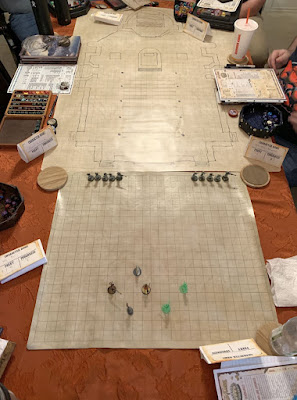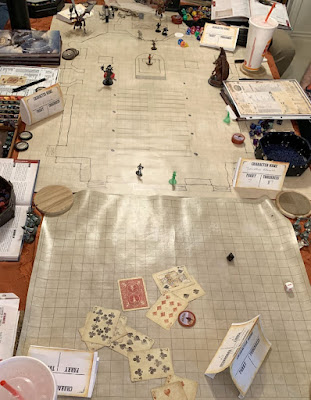I'm pretty happy with Savage Worlds as a system and I am glad that it seems to be more popular than ever now. One area I do see people questioning online is combat - particularly initiative and the damage system. Typically these people are coming over from D&D and don't really grasp that there are other ways of doing things but let's talk about these two things:
Initiative is done in Savage Worlds with cards. The GM deals out a card to each player and the high cards go before the low cards. This is a holdover from original Deadlands and Rail Wars but it just works. It's a physical reminder of when you go - once you go you toss in your card. Want to delay? Just hold onto it until you want to go. The game supports this mechanically through related edges - want to be faster? There's an edge that lets you take 2 or even 3 cards when initiative is dealt and you keep the best. For a level-headed character you can take an edge that lets you trade in your card if it's below a certain value.And yes, initiative is dealt every round. No it's not a big delay and yes, we played D&D for at least 20 years this way until 3E changed it to static initiative so it's not some radical new idea.
However this sometimes freaks people out as they bang away on an opponent and seemingly do nothing for several rounds. You might Shake them, or inflict some kind of condition with a power, but it bothers some people that there's no counter ticking down with every hit. This despite the truth that in D&D those hit points flying off have no impact on most NPCs or Monsters either - until the last one. In Savage Worlds if you are fighting an opponent who can take multiple wounds then each one of those will inflict a penalty on actions that creature takes. There are edges to offset these penalties, and powers that can do the same thing -"Numb" was a regular player in our campaign - but again that's another way to flavor a character or monster.
- I don't think I had a fight last more than 7 rounds in my entire campaign and once players have a little bit of experience the pace of those rounds is pretty quick. D&D 3E and Pathfinder in particular tended to have long combats made up of long rounds where players might get bored waiting for their next chance to act. That was never a problem here. Also, in spite of this faster flow, combat is still rewarding as many different approaches and tactics can be tried - it's not a static regimen of "hitting for X damage" round after round as you whittle away at the dragon.
- Furious comes into it when characters are doing things every round - there's not a lot of need for multi-round actions. Also, the rules allow for multiple actions beyond the basic move + act as much as a player wants to push things by imposing a -2 cumulative penalty to additional actions with no actual cap on how much one can try.
- Fun is a factor with interesting abilities from Edges and Powers plus mechanical things like manipulating the cards and facing tough choices on how to spend those bennies when things hit the fan. Also, exploding dice - particularly damage dice - add some excitement and occasionally some despair, depending on which side of the roll you are on.















